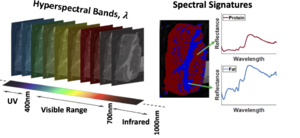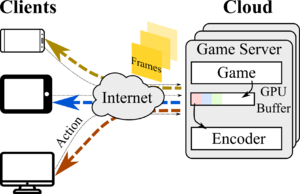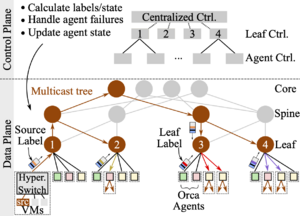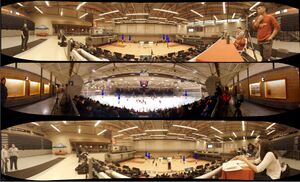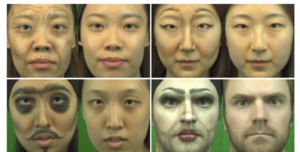Difference between revisions of "Network and Multimedia Systems Lab (NMSL)"
| (171 intermediate revisions by 13 users not shown) | |||
| Line 1: | Line 1: | ||
__NOTOC__ | __NOTOC__ | ||
| − | '''Welcome to the Network Systems Lab at SFU!''' | + | '''Welcome to the Network and Multimedia Systems Lab (NMSL) at SFU!''' |
| + | The Network and Multimedia Systems Lab is led by [http://www.cs.sfu.ca/~mhefeeda/ Dr. Mohamed Hefeeda,] and it is located in the TASC1 building, room 8208. | ||
| − | We are interested in the broad | + | We are interested in the broad areas of multimedia systems, machine learning, and computer networks. We develop algorithms and systems to efficiently distribute multimedia content to large-scale user communities over wired and wireless networks. We design machine learning models to address important and challenging problems in multimedia and network systems. Our current research projects include hyperspectral imaging, datacenter networking, scalable multicast systems, cloud gaming, multimedia forensics, mobile multimedia, and AR/VR content processing and streaming. In most of our works, we develop prototypes and testbeds to demonstrate the practicality of our solutions and show their performance in actual environments. |
| − | + | At a high level, our current research interests include: | |
| − | + | '''<big>Machine Learning for Multimedia:</big>''' We design learning-based solutions to address complex real-life problems that involve multiple modalities and entities, such as: | |
| + | * '''''Multimedia Forensics:''''' detecting makeup attacks in biometric systems using generative adversarial models, fighting content forgery and deepfake using deep watermarking, and detecting food fraud using hyperspectral imaging and deep-learning models. | ||
| + | * '''''Content Enhancement:''''' removing reflection in images using unsupervised learning models, and up-sampling of rendered contents in cloud gaming using deep learning. | ||
| − | |||
| − | |||
| − | * ''' | + | '''<big>Multimedia Networking:</big>''' We design systems for efficient encoding, processing, and delivery of immersive (3D, AR, and VR) multimedia content, such as: |
| + | * '''''Augmented and Virtual Reality (AR/VR):''''' automatically converting 2D videos to 3D and VR, and adaptively streaming AR/VR content to heterogeneous receivers. | ||
| + | * '''''Cloud Gaming:''''' designing next-generation cloud gaming systems that optimize video quality, player engagement, and required computing and bandwidth resources. | ||
| − | |||
| − | + | '''<big>Network Protocols and Systems:</big>''' We design protocols and systems to efficiently manage the resources of different networks and support the growing computation and communication demands of machine learning models, such as: | |
| + | * '''''Datacenter Multicast:''''' designing scalable multicast systems for datacenters to support efficient group communications patterns common in training machine learning models. | ||
| + | * '''''ISP and CDN Traffic Management:''''' developing algorithms to support multicast traffic engineering in ISP and CDN networks. | ||
| + | * '''''Datacenter Task Scheduling:''''' designing in-network, fine-grain, schedulers for micro-second scale tasks to support interactive workloads. | ||
| − | |||
| − | |||
| − | + | We publish papers in reputable conferences and journals. Most of our Journal Publications are in the premier IEEE and ACM transactions in our areas, such as IEEE Trans. on MM, ACM Trans. on MM, and IEEE/ACM Trans. on Networking. Similarly, most of our Conference Publications are in selective and high-quality conferences, including MM, NSDI, MobiCom, INFOCOM, ICNP, and MMSys. | |
| − | + | Brief descriptions and links to some of our active and concluded projects are given below. | |
| − | + | == '''Hyperspectral Imaging''' == | |
| + | {| | ||
| + | | Hyperspectral cameras capture scenes in many wavelength bands across the spectrum, providing far more information than regular cameras that operate in the visible light range. Hyperspectral imaging can be useful in many commercial/civilian applications such as agricultural research, land-cover mapping, forest monitoring, and mapping of natural disasters, as well as military applications including remote sensing, surveillance, and identification of camouflaged objects. | ||
| − | + | Despite the substantial potential of hyperspectral imaging, its utilization has been limited to a small subset of large-scale military and industrial applications. The long-term goal of this research is to enable the wide adoption of hyperspectral imaging in many real-life applications. | |
| − | + | '''[[Hyperspectral Imaging|Project Page ...]]''' | |
| − | + | || | |
| + | [[File:Hyperspectral signatures.png|thumb|Hyperspctral imaging.|right]] | ||
| + | |} | ||
| − | + | == '''Cloud Gaming''' == | |
| + | {| | ||
| + | | | ||
| + | Cloud gaming enables users to play games on virtually any device. This is achieved by offloading the game rendering and encoding to cloud datacenters. As game resolutions and frame rates increase, cloud gaming platforms face a major challenge to stream high-quality games due to the high bandwidth and low latency requirements. | ||
| − | + | The goal of this project is to design and implement a comprehensive, end-to-end, framework for next-generation cloud gaming systems to optimize the video quality, bitrate, and end-to-end delay. | |
| − | + | This project is supported by '''AMD Canada''' and an '''NSERC Alliance''' project. | |
| − | + | '''[[Cloud Gaming | Project Page ...]]''' | |
| − | + | || [[File:CloudGaming.png|thumb|Overview of cloud gaming architectures.|right]] | |
| + | |} | ||
| − | + | == '''Datacenter and ISP Networks''' == | |
| + | |||
| + | {| | ||
| + | | | ||
| + | We develop algorithms and systems to optimize the performance of datacenter and ISP (Internet Service Provider) Networks. This includes designing scalable multicast systems for datacenters and developing stateless and efficient protocols to support service chaining and multicast traffic engineering in ISP networks. | ||
| + | |||
| + | This work was supported by '''Cisco''' and an '''NSERC Strategic''' project. | ||
| + | |||
| + | '''[[Scalable Multicast | Project Page ...]]''' | ||
| + | || | ||
| + | [[File:Orca.png|thumb|Design of Orca (multicast system for datacenters). |right]] | ||
| + | |} | ||
| + | |||
| + | == '''Immersive and Next-Generation Videos''' == | ||
| + | {| | ||
| + | | With massive investments in augmented and virtual reality (AR/VR) hardware, companies encounter the challenge of providing VR content. The current solution for installing and operating VR camera rigs is expensive and not scalable. This project provides novel algorithms and methods to automatically convert standard broadcast 2D video streams to 3D and immersive VR streams of high quality. It also provides algorithms for adaptively streaming AR/VR content over the Internet to large-scale receivers. | ||
| + | || | ||
| + | [[File:VR2.jpg|thumb|right|Generating VR content from 2D videos. ]] | ||
| + | |} | ||
| + | |||
| + | '''[[Immersive_Videos|Project Page ...]]''' | ||
| + | |||
| + | == '''Multimedia Forensics''' == | ||
| + | {| | ||
| + | | Recent advances in machine learning have made it easier to create fake images and videos. Users and computing systems are facing increasing difficulties in differentiating forged contents from original ones. In this project, we focus on various aspects of detecting fake content, including detecting makeup attacks in biometrics systems and identifying forged videos and images. | ||
| + | |||
| + | |||
| + | '''[[Multimedia Forensics | Project Page ...]]''' | ||
| + | |||
| + | || | ||
| + | [[File:MakeupAttacks.png|thumb|right|Sample makeup attacks. ]] | ||
| + | |} | ||
| + | |||
| + | |||
| + | = '''''[[Concluded Projects]]''''' = | ||
| + | |||
| + | Please check [[Concluded Projects | '''this link''']] for some of our previous projects. | ||
Latest revision as of 14:10, 25 October 2023
Welcome to the Network and Multimedia Systems Lab (NMSL) at SFU!
The Network and Multimedia Systems Lab is led by Dr. Mohamed Hefeeda, and it is located in the TASC1 building, room 8208.
We are interested in the broad areas of multimedia systems, machine learning, and computer networks. We develop algorithms and systems to efficiently distribute multimedia content to large-scale user communities over wired and wireless networks. We design machine learning models to address important and challenging problems in multimedia and network systems. Our current research projects include hyperspectral imaging, datacenter networking, scalable multicast systems, cloud gaming, multimedia forensics, mobile multimedia, and AR/VR content processing and streaming. In most of our works, we develop prototypes and testbeds to demonstrate the practicality of our solutions and show their performance in actual environments.
At a high level, our current research interests include:
Machine Learning for Multimedia: We design learning-based solutions to address complex real-life problems that involve multiple modalities and entities, such as:
- Multimedia Forensics: detecting makeup attacks in biometric systems using generative adversarial models, fighting content forgery and deepfake using deep watermarking, and detecting food fraud using hyperspectral imaging and deep-learning models.
- Content Enhancement: removing reflection in images using unsupervised learning models, and up-sampling of rendered contents in cloud gaming using deep learning.
Multimedia Networking: We design systems for efficient encoding, processing, and delivery of immersive (3D, AR, and VR) multimedia content, such as:
- Augmented and Virtual Reality (AR/VR): automatically converting 2D videos to 3D and VR, and adaptively streaming AR/VR content to heterogeneous receivers.
- Cloud Gaming: designing next-generation cloud gaming systems that optimize video quality, player engagement, and required computing and bandwidth resources.
Network Protocols and Systems: We design protocols and systems to efficiently manage the resources of different networks and support the growing computation and communication demands of machine learning models, such as:
- Datacenter Multicast: designing scalable multicast systems for datacenters to support efficient group communications patterns common in training machine learning models.
- ISP and CDN Traffic Management: developing algorithms to support multicast traffic engineering in ISP and CDN networks.
- Datacenter Task Scheduling: designing in-network, fine-grain, schedulers for micro-second scale tasks to support interactive workloads.
We publish papers in reputable conferences and journals. Most of our Journal Publications are in the premier IEEE and ACM transactions in our areas, such as IEEE Trans. on MM, ACM Trans. on MM, and IEEE/ACM Trans. on Networking. Similarly, most of our Conference Publications are in selective and high-quality conferences, including MM, NSDI, MobiCom, INFOCOM, ICNP, and MMSys.
Brief descriptions and links to some of our active and concluded projects are given below.
Hyperspectral Imaging
| Hyperspectral cameras capture scenes in many wavelength bands across the spectrum, providing far more information than regular cameras that operate in the visible light range. Hyperspectral imaging can be useful in many commercial/civilian applications such as agricultural research, land-cover mapping, forest monitoring, and mapping of natural disasters, as well as military applications including remote sensing, surveillance, and identification of camouflaged objects.
Despite the substantial potential of hyperspectral imaging, its utilization has been limited to a small subset of large-scale military and industrial applications. The long-term goal of this research is to enable the wide adoption of hyperspectral imaging in many real-life applications. |
Cloud Gaming
|
Cloud gaming enables users to play games on virtually any device. This is achieved by offloading the game rendering and encoding to cloud datacenters. As game resolutions and frame rates increase, cloud gaming platforms face a major challenge to stream high-quality games due to the high bandwidth and low latency requirements. The goal of this project is to design and implement a comprehensive, end-to-end, framework for next-generation cloud gaming systems to optimize the video quality, bitrate, and end-to-end delay. This project is supported by AMD Canada and an NSERC Alliance project. |
Datacenter and ISP Networks
|
We develop algorithms and systems to optimize the performance of datacenter and ISP (Internet Service Provider) Networks. This includes designing scalable multicast systems for datacenters and developing stateless and efficient protocols to support service chaining and multicast traffic engineering in ISP networks. This work was supported by Cisco and an NSERC Strategic project. |
Immersive and Next-Generation Videos
| With massive investments in augmented and virtual reality (AR/VR) hardware, companies encounter the challenge of providing VR content. The current solution for installing and operating VR camera rigs is expensive and not scalable. This project provides novel algorithms and methods to automatically convert standard broadcast 2D video streams to 3D and immersive VR streams of high quality. It also provides algorithms for adaptively streaming AR/VR content over the Internet to large-scale receivers. |
Multimedia Forensics
| Recent advances in machine learning have made it easier to create fake images and videos. Users and computing systems are facing increasing difficulties in differentiating forged contents from original ones. In this project, we focus on various aspects of detecting fake content, including detecting makeup attacks in biometrics systems and identifying forged videos and images. |
Concluded Projects
Please check this link for some of our previous projects.

